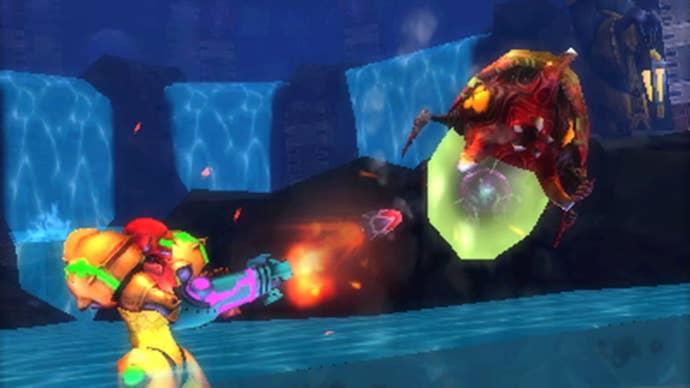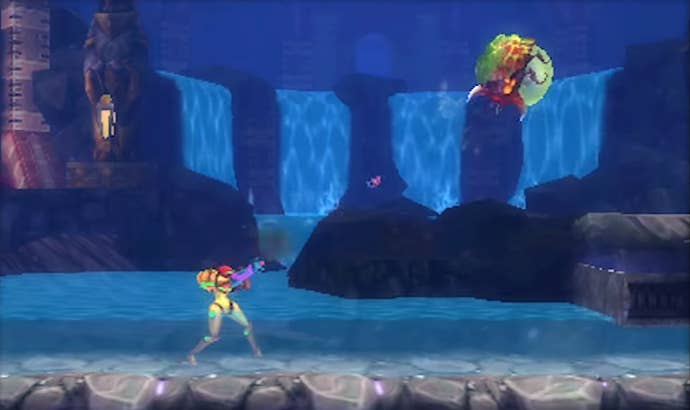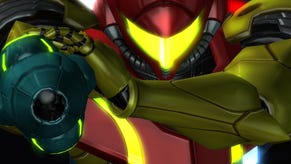Metroid: Samus Returns Review: A Near Perfect Remake of an Underappreciated Gem
At long last, Samus is truly back.
This article first appeared on USgamer, a partner publication of VG247. Some content, such as this article, has been migrated to VG247 for posterity after USgamer's closure - but it has not been edited or further vetted by the VG247 team.
Metroid II was my first Metroid game. Dark and atmospheric, with memorable monster designs and a great soundtrack, it left a definite impression on me. There was no denying that it was a flawed work, but its sense of creeping horror also made it an underappreciated gem on the Game Boy.
Unlike its predecessor and sequels, Metroid II was deliberately constrained, forcing you to clear each level before you were allowed to advance. It also had a rather different objective from its siblings: Kill Metroids. Lots of Metroids. Exploration was still important in Metroid II, but combat was even more at the forefront than usual.
As with many other 8-bit sequels, Metroid II's differences made it a bit of an oddball in its series, seemingly dooming it to the status of also-ran in discussions of Metroid's legacy. But popular interest has led to not one but two remakes of Metroid II, the second of which represents Nintendo's official stab at adapting it for the modern era.
Developed by MercurySteam (Castlevania: Lords of Shadow), the game that results is generally faithful to Metroid's basic structure, but also takes a number creative liberties. You're still hunting Metroids, but you have many more abilities, and the areas are much, much bigger. It also puts even more emphasis on combat, with far more elaborate enemy encounters and boss battles.
While it has plenty in common with its source material, MercurySteam clearly has their own vision for this remake: one that borrows heavily from Super Metroid. Their take on Metroid II leans heavily toward action, but still incorporates plenty of the complex traversal puzzles that the series is known for. And it works wonderfully.
Metroid: Samus Returns begins with the same premise that animated the original game: Samus is dispatched to SR3888 to wipe out every single Metroid, which is doable because there are apparently only around 40 of them in existence. Samus begins at the surface and slowly delves deep into the planet, where she encounters more and more powerful Metroids as she hunts for their queen. Along the way, she picks up numerous power-ups, including famous items like the Screw Attack and the Morph Ball, as well as some of the newer innovations from Super Metroid.
Like Metroid II, MercurySteam's remake gates progress with pools of acid, which keeps Samus from moving forward until she has cleared out all of the Metroids in a particular area. Outside of that, and the fact that the Metroids steadily evolve into new and more menacing forms, the 3DS remake is pretty much a totally new game.
The differences are evident the moment you first land on SR388 and begin to delve beneath the surface. If you've ever played the original game, you'll notice immediately that the layout of the opening area is totally different... and much bigger. Compared to Metroid II, Samus Returns is absolutely huge, and its areas are correspondingly complex. In true Metroid tradition, you will constantly come upon locked areas, some of which require items that you don't acquire until much later in the game. One side effect of this is that you are encouraged to return to areas you've previously explored: something that was absent amid the relentless forward momentum of the original game.
You won't find much—mostly optional add-ons like missile tanks—but it does have the effect of making SR388 feel like a more coherent whole, as opposed to a series of discrete sections. Plus it's good for completionists.

Aiding your exploration are the sorts of bells and whistles you would expect from a Metroid game. You get a map now, praise be, and teleporters that will beam you to different parts of the planets. These are extremely useful later in the game, when the areas get so big that backtracking becomes time-consuming. Meanwhile, a combination of the shoulder buttons and the touchscreen allow you to quickly activate your Ice Beam and missiles, making combat smooth and exciting.
I commented in an earlier piece linked above that Samus is a real badass in this remake, and that feeling only grows as you gain more abilities. Being able to aim freely with the help of the left shoulder button makes you immensely more dangerous. Your other skills come into play as well: when I ripped an extremely powerful foe from the ceiling with my grappling beam, I wanted to stand up and cheer. It just felt so great.
The combat is by far the most satisfying part of Samus Returns, and there are a lot of underlying factors that make it a success. MercurySteam leans heavily on old-school pattern recognition and never stoops to introducing cheap quicktime events. The battles are also balanced in such a way that your first encounter with a new enemy often pushes you to the brink. Even normal enemies can be daunting when you don't have the weapon you need to easily take them down.
You really feel it before you get your initial abilities, when just a couple hits are capable of killing you almost immediately. Flyers will zip in with their stingers, and until you get your timing right with Samus' new melee attack, you're apt to incur a good deal of damage. Even late in the game, when you're an unstoppable death machine with your Plasma Beam, you will still have to approach some enemies with a tactical mindset as mere damage isn't enough.
This is never more evident than in your battles with the Metroids scattered throughout the planet. These are intricate fights, and without giving away too much, you really have to pay attention to their individual weaknesses if you want to successfully take them down. Your first encounter with a new Metroid form is tense, beginning with a short cutscene in which Samus steps gingerly up to a discarded shell, followed by the new evolution bursting out of the darkness for a grand entrance. After that, you have to learn their complex patterns on the fly, which is especially tough against some of the most powerful evolutions.

These setpiece battles define Samus Returns, and they are infinitely more complex than they were in Metroid II. But there is a tradeoff: these elaborate encounters require their own spaces, meaning that you'll almost never get surprised by a Metroid while you're just exploring (though they will occasionally pop out of the blue). Personally, I missed the variety of fighting a Metroid in a sand trap, or using the Screw Attack to fend off a Gamma Metroid while dodging between a couple blocks high up in the air. But I was able to set aside my misgivings in light of how cool the battles were, especially in the latter half of the game.
The rest of Samus Returns is about getting to these fights, which is where the exploration comes in. In addition to its enemies, Samus Returns has water, lava, superheated rooms, and lots of hidden blocks to bomb. In fact, there are so many bombable blocks that one of Samus Returns' new abilities is a scanner that reveals what you can remove to proceed. The rest of the time you'll find yourself scrutinizing the map and asking, "Where haven't I been yet?" And as the layouts become more complex, you'll find yourself asking that question more and more.
These labyrinths are not difficult to solve—I can't recall ever being genuinely stuck—but that does not make them any less rewarding to complete. The bigger areas in particular take on lives of their own as you uncover new items, access new areas, battle minibosses, and knock out Metroids. Then, when you finally kill the last of the Metroids on that level, you get that satisfying ping from the main shrine to indicate that you're done (no more random earthquakes—now you turn in Metroid DNA to unlock the next area).
Over the course of the 10 hours or so that it took to complete Metroid: Samus Returns—during which I uncovered a scant 40 percent of the map—that loop kept me pretty much glued to my 3DS, eager to find the next Metroid and reach a new power-up. It definitely feels like a Metroid game, down to its updated tracks from Super Metroid and Metroid Prime. I daresay that it's even beautiful, which is not something I say very often about a 2D game with 3D graphics. MercurySteam really pushes the 3DS to the limit, with the late battles featuring some of the best graphics the platform has ever seen.

Best of all: It's minimalist. Samus doesn't have an A.I. boyfriend telling her what to do. She doesn't have deep-seated fears to overcome. What storytelling there is unfolds over a handful of short but highly effective cutscenes, and that's all it really needs.
In almost every respect, Samus Return is a near perfect remake. It grasps much of what worked in the original and dramatically heightens it while minimizing its flaws. There are so many great little touches throughout Samus Returns, from the menacing red eye of the mysterious... thing... stalking you throughout SR388, to the slime dripping in the background of the massive egg chambers at the heart of the planet.
I think there's an argument to be made that its structure is still a bit too rigid when compared to its peers—a holdover from the original game. And without the Game Boy game's weird, dissonant soundtrack, it loses a little bit of its spookiness. But then you get to the egg chamber, and all the sudden the remake feels every bit as creepy as the original. Speaking as a longtime Metroid fan, Samus Returns had me grinning like a maniac.
All told, Samus Returns is a strong comeback that stakes a legitimate claim on being the best game on the 3DS. MercurySteam has executed on this remake wonderfully, sliding in seamlessly with the rest of the series. It's been a long, frustrating seven year wait, but it's great to have Metroid back. Here's hoping it won't be leaving again any time soon.
InterfaceAn excellent interface makes it easy to seamlessly switch between weapons and access the map, making the combat feel that much better.
SoundMercurySteam wisely doesn't try to mess with success here. Samus Returns mixes tracks from Metroid Prime, Super Metroid, and the original Metroid II, and the results are great.
VisualsMercurySteam really makes use of the flexibility afforded by 3D graphics. The backgrounds are lively and interesting; some bosses make use of the 3D space, and there are little cutscenes sprinkled throughout. The latter half in particular is where Samus Returns really flexes its graphical muscle.
ConclusionI was delighted by Metroid: Samus Returns. It hits pretty much every note you hope to see in a Metroid game, and MercurySteam's console background is evident in their flair for the dramatic— whether in their introductory cutscenes or their boss battles. Their dramatic reinvention reinvigorates the source material and strengthens the story's bridge to Super Metroid. In short: They nailed it.















